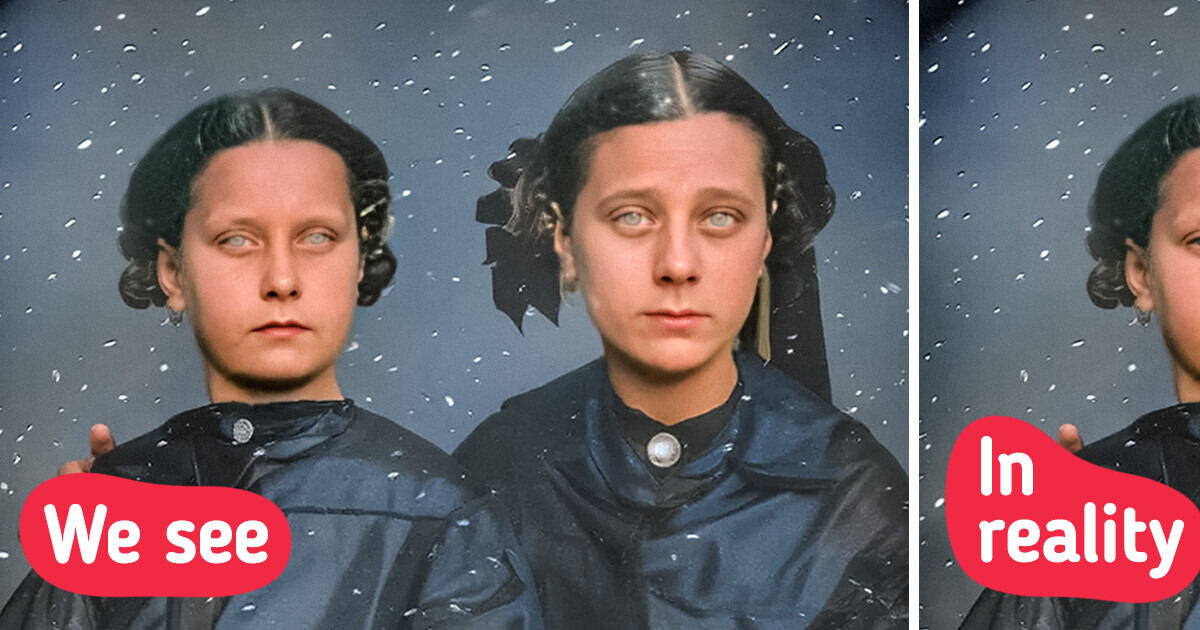14 Innocent Souls Who Learned a Lesson the Hard Way


The first cameras were far from perfect, so many photographers had to use all sorts of tricks and invent new technologies to take bright and interesting photos. That’s why we still use many of these techniques, such as photomontage, retouching, combined and hidden photography, and they appeared in the 19th century. We decided to find out what secrets are hidden behind old photos.
The first photograph of the Earth’s surface from the air was taken by the famous French photographer Nadar in 1858 during a balloon flight. Ballooning fascinated Nadar so much that he decided to build a huge balloon, which he named The Giant. Instead of an ordinary basket, the balloon was equipped with a real 2-story cottage, which contained 2 cabins, a balcony, a printing room, a photo lab, a toilet and a storeroom.
To promote his invention, Nadar took some studio shots of him and his wife posing in the balloon basket suspended above the floor. Unfortunately, 2 flights ended unsuccessfully. The first time, The Giant flew only 15 miles and made a hard landing. During the second flight, the balloon, while descending, encountered a strong wind, landed at a too high speed and bounced on the ground like a ball, almost crashing into a train. During one of The Giant’s flights, both Nadar and his wife were injured, and his love for ballooning nearly made Nadar a bankrupt.
Inventor Julius Neubronner apparently didn’t want to face similar problems, so in 1907 he patented a new, unusual method of aerial photography. He used trained pigeons to photograph the Earth. Compact cameras were attached to the birds, and the pigeons flew around the area and took pictures.
After Neubronner demonstrated this technique at an international exhibition, he immediately gained worldwide fame. In front of an amazed audience, the pigeons flew up to the man, who immediately developed the film, printed postcards and sold them.
10 years before James Clerk Maxwell took the first color photograph in 1861, another photographer, Levi Hill, claimed to have been able to produce about 45 colorful daguerreotypes. This claim caused a real sensation in the photographic community. Hill promised to reveal the secret of color photography for a reasonable fee once he had patented his technology.
Experts were delighted by the “hillotypes” — that’s how they nicknamed Levi’s pictures. However, as time went on, there was no news from Hill, and many people concluded that his photos were just fakes. As a result, Levi was unable to obtain a patent for the invention, and his book A treatise on heliochromy which described the technique of creating color pictures, was only ridiculed.
The photographer died being labelled a fraud. Just recent research showed that Hill was actually able to create color photographs. He retouched the frames to add missing colors, but the pictures originally contained distinguishable colors. Researchers still can’t understand how a simple photographer from a small town, who didn’t have necessary knowledge and special education, was able to come up with such a sophisticated technique.
The first photographs had to be taken at slow shutter speeds, so the images were often partially backlit: buildings and people looked good, but the sky looked like a white blur. Photographers began to experiment by combining several negatives at once when printing so that all the details would be reflected in the image. This technique was called combination photography.
It was pioneered by Oscar Gustave Rejlander and Henry Peach Robinson. The latter became famous for his staged shots in which members of his family appeared as models dressed in costumes. The photographer claimed that these photographs required no less skill from the artist than paintings. Robinson used 6 negatives to create When the Day’s Work Is Done.
Oscar Gustave Rejlander pioneered art photography and endeavored not just to capture a model or a landscape, but to create a work with meaning. Rejlander made extensive use of photomontage, combination printing and retouching. His most famous photograph, Two Ways of Life, was created from no less than 30 negatives.
The point is that Rejlander needed to photograph a large group of people. In those days, it was almost an impossible task: if even one model moved, the shot would be ruined. So, the photographer shot all the people individually and then superimposed the negatives one on top of another. This filigree work took about 6 weeks: some of the negatives had to be cut out, others had to be penciled to emphasize the contours.
The finished work had to be printed on 2 sheets of paper — the largest photograph of the time. It was over 28 inches wide. The image caused a storm of emotions among the public, many of whom were outraged by some of the details of the photograph. However, the critics were silenced when Queen Victoria bought the photograph as a gift for her husband.
Before becoming a famous scientist, Carl Størmer was fond of photography. The young man became interested in photography when he noticed a beautiful stranger in the street. 19-year-old Carl Størmer was too shy to introduce himself to the attractive girl. So he decided to buy a miniature camera, hide it behind a button and secretly take a few pictures of the young lady for memory.
The ethically questionable act led to unexpected consequences: Størmer became passionate about street photography and began taking photos of passers-by on the streets of Oslo. Over the course of 4 years, he took a lot of photos of both ordinary citizens and celebrities.
It is thanks to Størmer that we can now learn many details of city life in the late 19th century. As people usually didn’t know that Størmer took photos of them, they behaved naturally. Carl Størmer organized his first major exhibition of his work only when he was 70 years old.
In recent years, a variety of different materials have appeared online, suggesting that people in the Victorian era ordered studio photographs of their deceased relatives as a memento.
As evidence, researchers point to unnatural poses, strange facial expressions, and special devices that allowed the head and hands to be held in a certain position.
One photographer tried to find out how true these claims were, and found no mention in the 19th-century documents that these photos were popular. Most likely, the mounts were needed for regular studio customers. Even with a shutter speed of one second, it is quite difficult to get a clear shot of a person — that is why the head and hands were fixed in a certain position. However, the constructions were too light and unreliable to hold a dead body.
In addition, the long exposure gave a strange hue to the skin, and the blue eyes turned white. Unfortunately, the theory about the mysterious habits of ancestors proved too attractive to the public, and people eagerly continue to share these photos.
In the 19th century, photo studios were very popular places where the cream of society gathered. Some establishments could occupy a whole 3-story building. Every decent photographer had to offer his clients suitable props and all kinds of backgrounds.
Various chairs, benches, tables, couches not only helped people to take a suitable pose, but also emphasized the social status of those being photographed. However, sometimes the pictures still turned out unnatural, so it was necessary to spend a lot of time in the studio to take a good shot.
To make their hands look more natural, women were given small objects. These not only helped them to adopt the right pose, but also reflected the positive traits of the client. A handkerchief symbolized a sensitive and delicate nature, and a book showed a thirst for knowledge.
Customers could order special treatment for the resulting photo. Standard services included painting the outfit in red and blue colors, as well as applying pink paint to the cheeks and lips.
In addition, the photographer could gild jewelry at the request of the lady. Some professionals pointed out that a good photograph required not only a camera but also a pencil.
In the second half of the 19th century, the public was crazy about all things mystical. Not surprisingly, some photographers rushed to take advantage of this. By using double exposure, where one plate is used to take a picture twice, they created mysterious photos in which people seemed to be photographed with ghosts.
Usually, one figure looked distinct and bright, while the other seemed blurred and ephemeral. Other professionals created collages using combination printing. Despite the outrage of some people, these images were immensely popular with a wide audience.
In 1851, photographer André Adolphe-Eugène Disdéri patented a camera equipped with 4 lenses. With this device, it was possible to make 8 small negatives at once instead of one large one. This dramatically reduced the cost of photography and made it affordable.
Disdéri’s invention started the craze for small photos, also called “visiting cards” (cartes-de-visite). In almost every home, you could find an album with photos of family and friends. However, people collected not only cards of acquaintances. They enthusiastically bought pictures of celebrities: aristocrats, actresses, and people who just happened to be famous.
Fame could come to a model unexpectedly. In those days, photographers had all the rights for the photos and could sell them in any quantity without the model’s permission. Some young men could buy a card of a strange girl and then brag that they had received it as a gift from the young lady herself. Rumors like this could sometimes ruin the reputation of the girl.
However, some people used this universal love to “visiting cards.” If their photo was in demand and their face became famous, they continued to be photographed to gain even more fame. The albums with “visiting cards” were in a way similar to modern social networks.
And here are 11 world-famous photos that have a fascinating story behind their creation.











